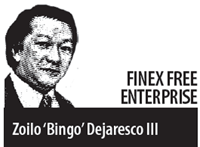
Then there is the horrible cost of dying—the funeral services—such that the term KBL or “Kasal, Binyag, Libing” became a politician’s almost obligatory lookout.
Years back, the poor were treated arrogantly. They were refused hospital entry if they did not have the money for deposit; were kept hostage in the hospital if they were not able to pay their hospital bills.
Before the Generics law, unscrupulous doctors also prescribed exorbitantly priced medicine brands that killed the poor sooner than their ailment would have. Transport was so difficult that the “Doctors to the Barrios” volunteer program under the late Department of Health Secretary and Sen. Juan M. Flavier came into being.
Over the years, as the economy progressed and the government had the wherewithal and the conscience to help the poor, things have, finally, changed.
The government had always aimed to “give free medicines and hospitalization” to the poor because, frankly, their income was just enough for a hand-to-mouth existence. What is the solution?
According to Undersecretary Presidential Assistant for the Visayas Michael Lloyd Dino, by April this year the Celestino Gallares Memorial Hospital (currently in Tagbilaran City) and the Don Emilio del Valle Memorial Hospital (Ubay, Bohol), Saint Anthony Mother and Child Hospital (Cebu City), Eversley Child Sanitarium Hospital (Talisay, Cebu) and the Talisay District Hospital (Talisay) will implement the “Malasakit Center.”
The pilot project was recently opened in Cebu at the Vicente Sotto Memorial Medical Center from which the five other hospitals will draw lessons from once they open their respective centers.
Under the Malasakit Center Concept, the indigent patients will fill up only one form and will not spend time and money visiting various agencies to get separate approvals. The poor man’s application will be processed simultaneously under the “help the poor” budget of the Department of Health, PhilHealth, Department of Social Welfare and Development, and the Philippine Charity Sweepstakes Office.
In the past, if one had no political connections or does not know the medical center personnel, the homes of the poor became “Mona Lisa” centers—where “the sick just lie there and they die there.”
Dino reiterated that it is the government hospitals who provide the Malasakit Center office within the hospital premises; if the four agencies run out of GAA budget, the office of the Presidential Assistant for the Visayas will provide the gap.
The six hospitals were chosen on the basis of the number of indigent patients who registered there in the past. Soon, 50 other hospitals in the Visayas will also have their own Malasakit Center.
The Malasakit Center program could be the answer to a longing to have a one-stop office to help defray the high cost of hospitalization, especially for the poorest of the poor.
This can’t be but “helping the least of our brethren,” as the Holy Book says.
The “brains” behind the Malasakit Center is Michael Lloyd Dino, 48, who gave up a lucrative COO position in a real-estate group to found “Bisaya na Pud,” a movement organized to help then-Mayor Rodrigo Duterte (who speaks Cebuano) into the presidency in 2016.
A La Salle business graduate, Dino was asked by the President to find projects to help the poorest of the poor in the Visayas.
Fortunately, Dino is no politician and does not hanker for any elective post. He says: “I will not stay one day longer in government office than the President.”
****
Bingo Dejaresco, a former banker, is a financial consultant, media practitioner and book author. He is a life member and chairman of the Broadcast Media of Finex.
His views here, however, are personal and do not necessarily reflect those of Finex. dejarescobingo@yahoo.com.





















5 comments
Nice..Hapit na muabot ang panahon nga lukop Visayas na ang naay Malasakit Center ni Digong. Congrats kang Sir Dino.
Good Job DUTERTE ADMIN!.. hapit na managhan ang Malasakit Center. makaexcite mani oi. Sa Leyte pud tana isunod.
Saludo ko nimo PAV Dino aning imong project. Tana sauna ra ni natukod nga project. hehehe tana sauna ra ka nahimong PAV para karong tuiga, daghan na malasakit center. Cguro mga tibuok Pinas na.
Salamat President Digong. Dghang salamat Sec Dino.
Elibs na jud ko ni Sir Mike ba. Paspas kaayo magtrabaho. Nice one Sir.